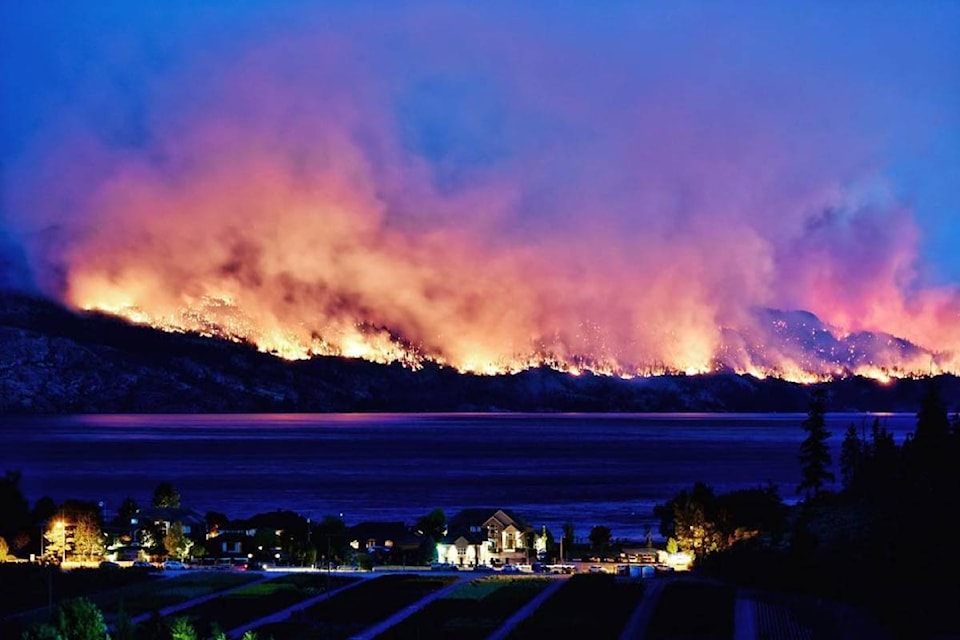A UBC wildfire expert says Okanagan wildfires have the potential to become massive firestorms because of the amount of dry fuels available.
David Andison, with the Department of Forest Management Resources at UBC, said the recent hot weather and winds dry out fuels quickly, and winds bend flames towards other flammable fuel.
When wildfires become large enough, usually thousands of hectares in size, they use so much energy they are able to affect the surrounding area and weather patterns, he said.
��ѻ��ý�Because they are consuming so much energy they need oxygen and so what they do is suck oxygen in. I��ѻ��ý�ve got pictures of fires where on the edge the trees are actually bending over at a 45-degree angle towards the fire and it��ѻ��ý�s the oxygen being sucked in because it��ѻ��ý�s consuming so much at such a rapid pace,��ѻ��ý� Andison said.
The mushroom cloud shaped smoke will influence other weather patterns around it and it can create its own clouds, as well as thunder and lighting, he said.
��ѻ��ý�These fires are sometimes compared to massive bombs because at their core they consume so much energy,��ѻ��ý� he said.
It is unlikely the fires currently burning in the Central Okanagan have those effects, but Andison said more needs to be done in terms of fuel management.
��ѻ��ý�What you want to have is a landscape where you have fire happening on a fairly regular basis. What��ѻ��ý�s happened in the Okanagan is we��ѻ��ý�ve been really successful at putting fires out, and a lot of them would��ѻ��ý�ve been smaller fires��ѻ��ý� that would��ѻ��ý�ve gone out, but it would have created different patches of forest, different ages, different types, different densities and you wouldn��ѻ��ý�t have this blanket,��ѻ��ý� he said. ��ѻ��ý�By putting fires out, it encourages all of the forests to become older and dense and highly flammable.��ѻ��ý�
Andison said controlling the landscape is less expensive than firefighting.
��ѻ��ý�The combination of mechanical means to do some thinning to get in there and take trees out and do prescribed burns and, in more remote areas, manage wildfires,��ѻ��ý� he said.
If it isn��ѻ��ý�t near a population, it��ѻ��ý�s better to let the fire burn, creating pockets of landscape with no fuel, he said.
And the fire seasons in Canada are only going to get worse, according to Andison.
��ѻ��ý�Until we get ahead of it, it will be the way the things are. We created this situation largely because of climate control, but now it��ѻ��ý�s being compounded because climate change is creating longer fire seasons and more severe ones,��ѻ��ý� he said.
Forestry manager Kerry Rouck for Gorman Brothers Lumber said the company has been working with the Penticton Indian Band to monitor fuels next to its areas of logging.
Yet, B.C. fires don��ѻ��ý�t cause the same amount of devastation compared to our neighbours in the south. Last year, more than 40 people died from California wildfires, according to the . The 2017 B.C. wildfire season was one of the worst in the province��ѻ��ý�s history, but no deaths were reported, according to the province.
Andison said California��ѻ��ý�s constant winds, and forest fuels that only take years to build up opposed to decades in B.C. and the state��ѻ��ý�s population size are contributing factors.
��ѻ��ý�I think it��ѻ��ý�s a whole different risk situation��ѻ��ý�. there are people everywhere and a lot of the fires you see pictures on the news in the northern parts of Canada, if the winds pick up you��ѻ��ý�ll see people being pulled off the fire,��ѻ��ý� he said.
Related: Okanagan Mountain Park fire shows no growth overnight
Related: Wildfire near Peachland shows no growth overnight
carli.berry@kelownacapnews.com
Like us on and follow us on .



